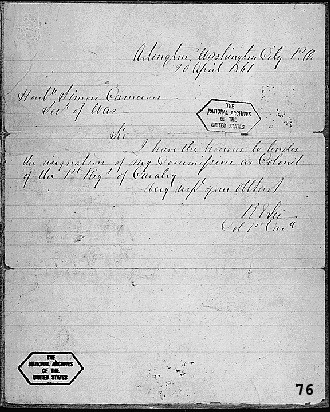
|
U. S. CIVIL WAR
PHOTOGRAPHS
|

|
 1
1
Robert E. Lee
1807 - 1870
ROBERT E. LEE
(Page One of Six)
In the text, the icon  is a link to the definition of the word it marks. is a link to the definition of the word it marks.
Use your
browser's "back"
button to return to this page.

President Franklin D. Roosevelt
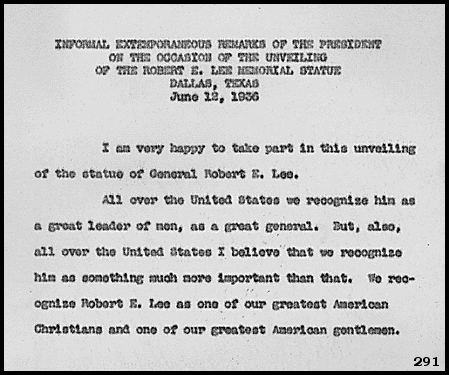
President Franklin D. Roosevelt's Remarks About Robert E. Lee
(For a more readable text, click
Here.)
| |
Robert Edward Lee was born on January 19, 1807, at "Stratford" in
Westmoreland County, Virginia. He was the fifth child born to
Henry "Light-Horse Harry" Lee and his second wife, Ann Hill
(Carter) Lee. He grew up in an area where George Washington was
still a living memory. Robert had many ties to Revolutionary War
heroes.
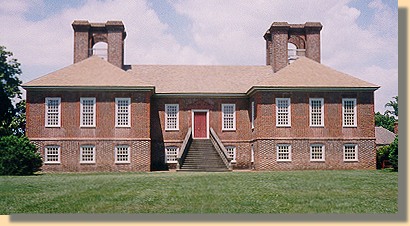
Stratford - 2001
Educated in the Alexandria, Virginia, schools, he obtained
appointment to West Point in 1825. In 1829, Robert E. Lee
graduated second in the class without a single demerit against his
name. He was commissioned a brevet 2nd Lieutenant of Engineers. 2nd Lieutenant of Engineers.
On June 30, 1831, Lee married Mary Ann Randolph Custis.
They had seven children.
All three of their sons served in the Confederate army
 . George Washington Custis and
William Henry Fitzhugh ("Rooney") attained the rank of Major General and
Robert E. Lee, Jr., that of Captain. The latter served as a
private in the Rockbridge Artillery . George Washington Custis and
William Henry Fitzhugh ("Rooney") attained the rank of Major General and
Robert E. Lee, Jr., that of Captain. The latter served as a
private in the Rockbridge Artillery at the Battle of Antietam. at the Battle of Antietam.
|
During the Mexican War, Robert E. Lee, for his gallantry and
distinguished conduct in performing vital scouting missions, was
promoted to; Brevet Major for his actions at Cerro Gordo; Brevet
Lieutenant Colonel for Contreras-Churubusco; and Brevet Colonel for
Chapultepec. The Army designated officers by the highest brevet
rank attained, and so, Lee, although not receiving Colonel's pay, carried
the title "Colonel" after the Mexican war. (For more information on Lee's
actions in the Mexican War, refer to the book "Lee" by Douglas Southall Freeman.)
In 1852, Lee became Superintendent of the Military Academy and began receiving
Army pay equivalent to his Brevet rank, Colonel. In 1855, Secretary of War
Jefferson Davis transferred Lee from staff to line and Lee was commissioned
Lieutenant Colonel 2nd Cavalry. This did not give him any additional
compensation, since he was already receiving Brevet Colonel pay. However, it
did make his actual rank closer to his highest Brevet rank. He was then sent
to West Texas, where he served from 1857-1861, during which time he received an
extended leave due to the death of his Father-in-Law.
The destruction of slavery in the United States was the driving
ambition of abolitionist John Brown. He came to believe that it would
take bloodshed to root out the evil of slavery, and by the mid-1850s he
dedicated himself to an all-out war for slave liberation. On
October 16, 1859, he and his "army" of some 20 men seized the federal
arsenal at Harpers Ferry, Virginia (now West Virginia). By the morning of
October 18, marines under the command of Bvt. Col. Robert E. Lee, stormed
the building and captured Brown and the survivors of his party. The
operation that Brown envisioned as the first blow in a war against
slavery was over in 36 hours.
(Source: National Archives and Records Administration)
|
It was during this leave, in October 1859 that Lee was ordered to take a
detachment of U.S. Marines and four companies of Maryland Militia to
Harpers Ferry in order to suppress an attempted insurrection caused by the
radical abolionist John Brown. Brown and his men, with hostages, had taken
refuge in the Fire Engine house within the armory enclosure. Lee sent Lt.
J.E.B. Stuart, under a white flag, to deliver a message from him demanding that
Brown and his men surrender.
| |
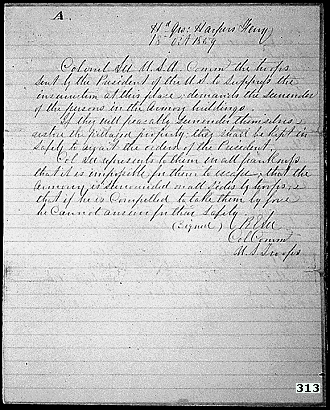
Lee's Letter Demanding John Brown's Surrender at Harpers Ferry
Source:
National Archives
Click
Here to read the text.
|
|
When Brown refused to surrender, Lee's Marines overran Brown's people in the
Fire Engine house, leaving four men dead, and Brown with a bayonet wound. All
thirteen hostages were safe.
In February of 1861, General
Winfield Scott recalled Lee from assignment in West Texas (See above) when the
lower South seceded from the Union. On March 18th, Lee was promoted to Colonel
by an order signed by Abraham Lincoln
Politically, Robert E. Lee was a Whig. Ironically, he was attached
strongly to the Union and to the Constitution. He entertained no
special sympathy for slavery.
(For Lee's opinion on slavery read his letter dated
December 27, 1856)
When Virginia withdrew from the Union, Lee resigned his commission rather than
assist in suppressing the insurrection.
His resignation was two days following
the offer of Chief of Command of U.S. forces under Scott. He then proceeded to
Richmond to become Commander-in-Chief of the military and naval forces of
Virginia. When these forces joined Confederate services, he was appointed
Brigadier General in the Regular Confederate Army.
In March of 1862 Lee became military advisor to President Davis in Richmond.
On May 31, when General Joseph E. Johnston was wounded during the battle of Fair
Oaks, Davis appointed Lee, Johnston's replacement. Lee took over the Confederate
Army of the Potomac, which he renamed the Army of Northern Virgina, and
stopped McClellan's threat to Richmond during the "Seven Days" Battle
(June 26-July 2, 1861). At the Battle of Second Manassas, Lee defeated
Pope. At the Battle of Antietam, his Northern thrust was checked by McClellan;
however, he repulsed Burnside at Fredericksburg in December of 1862. In May of
1863, Gen. Lee defeated Gen. Hooker at Chancellorsville, but was forced onto
the strategic defensive after Gettysburg in July. On April 9, 1865, Lee
surrendered to Ulysses S. Grant at the village of Appomattox Court House.
After the surrender, Lee returned to Richmond. He assumed the presidency of
Washington College (now Washington and Lee University). His example of conduct
for thousands of ex-Confederates made him a legend even before his death on
October 12, 1870. General Robert E. Lee is buried at Lexington, Virginia.
(Source:
U.S. Gov't, National Park Service and Others.)
Editor's Note: Robert E. Lee was involved, either directly or indirectly, with
most of the Civil War events described on this website. To show all of the
photographs from the events or battles involving Lee would require the inclusion
of most of the approximately 700 photographs on this site. Instead, I shall
present, in this section, only the photographs directly involving Lee.
These photographs also appear on the pages in which they are appropriately part
of a battle or event.
PRE-CIVIL WAR
|
|
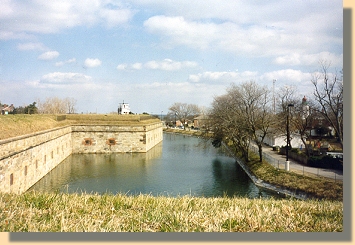
Fort Monroe - Outer Wall and Moat.
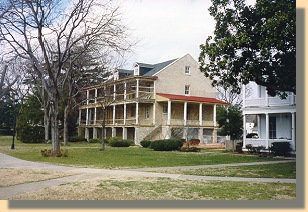
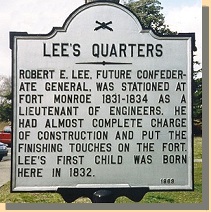
Lee's House (currently being renovated) at Fort Monroe. The sign
tells the story.
ROBERT E. LEE - PAGE 2
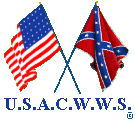 >
Civil War Photos
>
Robert E. Lee
>
Page 2
>
3
>
4
>
5
>
6
>
Civil War Photos
>
Robert E. Lee
>
Page 2
>
3
>
4
>
5
>
6
Notes
|
|


 1
1








